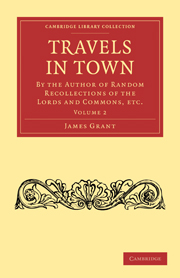CHAPTER X - RELIGIOUS DENOMINATIONS
Published online by Cambridge University Press: 29 August 2010
Summary
In a chapter devoted to the “Religious Denominations” of London, the Episcopalians are entitled to a priority of notice, not only as a matter of courtesy on account of their religion being the established religion of the country, but as a matter of right, from the circumstance of their being, by far, more numerous than any of the various other sects in the metropolis.
The places of worship belonging to tne Church of England in London, taking, as is always done in such cases, the metropolis and its suburbs to comprehend a circuit of eight miles from St. Paul's, are, including those additional churches erected within the last twelvemonths, about 320. Of this number, 240 are churches; the remainder are chapels. The chapels are divided into two classes; those which are parish chapels, and those which are private property. As nearly as I have been able to ascertain, about fifty are parish chapels, and thirty the property of private persons. Among the latter class of chapels, are St. John's Chapel, Bedford Row, where the Hon. and Rev. Baptist Noel preaches; Gray's Inn Lane Chapel, which is under the pastoral care of the Rev. Mr. Mortimer; and Tavistock Chapel, Drury Lane, where the Rev. Mr. Hall, the successor of the late Rev. Mr. Wilcox, statedly proclaims the truths of the gospel. The appointments of ministers to the parish chapels are, in most cases, under the control of the Vicars or Rectors of the respective parishes. Thus, for example, Dr. Moore, the Vicar of St. Pancras, has the patronage of no fewer than five places of worship in the immediate neighbourhood, including Camden Town, Kentish Town, and Somers Town Chapels.
- Type
- Chapter
- Information
- Travels in TownBy the Author of Random Recollections of the Lords and Commons, etc., pp. 89 - 326Publisher: Cambridge University PressPrint publication year: 2010First published in: 1839



